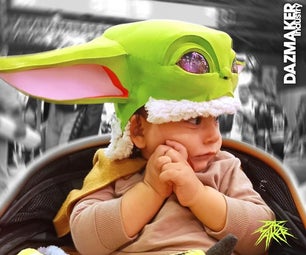Introduction: Bohemian Charm Necklace in Purple
I have a lot of mismatched purple beads I want to use because they are so pretty and deserve a chance to shine. I've flipped through a lot of jewelry magazines trying to get inspiration for ways to use these beads. I've seen many designs that have one big bead and the rest are smaller, mismatched ones that serve to accent that one bead. My big ones aren't huge showcase pieces, but I liked the idea of putting a bunch of them together like that, allowing their uniqueness to accentuate each other.
I came across a bracelet design that mimicked the look of a charm bracelet but the charms were just made with beads strung on a head pin or eye pin. Each pin had one big bead and one or two smaller seed beads to accent it. An idea began to form in my head.
What if I made a charm necklace? I think a necklace with a bunch of charms hanging off the chain would be a perfect way to allow these fun and unique beads to shine. I could even add some of the smaller mismatched beads to allow them to work with the bigger ones, and they can all have their moment in the spotlight.
Supplies
Materials
- Purple donut pendant
- Mixed purple beads in a variety of sizes
- Antiqued brass metal beads (optional)
- Hemp cord in lavender and deep purple
- Antiqued brass chain with medium sized links
- Antiqued brass cone ends
- 22 gauge antiqued brass wire
- Antiqued brass necklace clasp
- 11-15 antiqued brass eye pins or head pins
- 14-18 6mm antiqued brass jump rings
Tools
- Scissors
- Needle with large eye like a darning needle (optional but very helpful)
- Side cutters
- Round-nose jewelry pliers
- Chain-nose jewelry pliers
Step 1: Planning Design
I have a purple resin donut I wanted to be the centerpiece of this necklace. I have hemp cord to tie to the donut, but I need chain to hang all the charms on.
I decided I could tie the hemp cord on, thread it through the chain and have both work together. I wanted to use the hemp cord because it adds more color and gives the necklace a Bohemian style look. The Bohemian style is a carefree look, meant to inspire a sense of play and wonder. It's the perfect option for using a lot of mismatched beads.
I cleared off my table and put my beads, donut, chain, and hemp cord in front of me. I just started making basic shapes with the pieces to figure out how the necklace would look. I don't want to overly plan the whole design (that wouldn't be the Bohemian way), but I do want to have a basic idea of how I'm going to put it together.
As I was playing with various looks, I dropped part of the chain down through the center of the donut, out the front at the bottom, and thought that would be another way to use more beads. I have a heart-shaped stone bead that has the same coloring and swirly look as the donut that could hang at the bottom of that chain.
I had a basic look decided, but then I needed to figure out the tricky part. How will I attach both chain and hemp cord to the donut, keep everything in place, and allow for that extra chain to hang down the middle?
I decided I'd use the hemp cord as the main anchor to keep it all together. I would put that on the donut first. Then I would connect the two side chains and the short middle chain at a single point together with a jump ring. I would place that behind the donut and thread the hemp cord through the side chains to keep them on.
Step 2: Starting the Chain
Measure and cut hemp cord
Measuring the hemp cord and chain was more of an educated guess than an exacting process.
I held the donut up where I thought it should rest on my chest, then I ran the hemp cord from that point up and around to the middle of the back of my neck. I doubled that length and added 7 inches to provide extra room for tying the knot on the donut and weaving it through the chain. Any excess could be cut off later. It's better to have too much than not enough.
Then I held that length of cord next to the other color and cut the other color the same length. I cut two of each color to have four lengths of cord total.
Measure and cut chain
For the chain, I measured the length just as I did for the first part of the cord, measuring from where the donut should rest up to the middle of the back of the neck.
I separate this section from the rest of the chain by opening the link just after where I wanted the section to end. My chain has open links. If you have chain that doesn't open, you'll need to cut the next link with your side cutters.
To open the link properly (to keep it from losing integrity), you open it like you would a jump ring, using chain nose pliers on either side of the opening and twisting it like a spiral rather than pulling the link apart sideways. See Diagram 1 above to see how this is done.
Create two sections of chain the same length. Because my chain twists, I had to smooth the cut chain section out flat on my table, turning the links that had kinked up, and lay the other chain next to it to make sure I was getting the right length. Sometimes gravity helps with this. You can hold the chain up and work out the kinks before laying it back down on the table.
Then I created another chain section about 1.5" long for the middle part going through the donut.
Tie lark's head knots to both sides of donut
To attach the hemp cord to the donut, I used one of each color cord for each side, folded them in half, pushed the folded end through the donut from the back, pulled that up over the edge of the donut, and passed the cord ends through that loop to form a lark's head knot (see first photo above and Diagram 2). I pulled it tight and then did the same for the other two cords on the other side of the donut.
This is the knot typically used to begin macrame projects or attach yarn, cords, or string to rings, hoops, or pendants. Make sure when you fold the cords in half the ends are all even.
Connect three chain sections
Open a jump ring, slide one end of a long chain section on, then the short chain section, and the other long chain section. Then close the jump ring by reversing the twist. It should look like a really short-tailed Y when you're done.
Step 3: Weaving
So, at this point I was kind of winging it. I wasn't entirely sure my idea would work as it did in my head. But it's always good to explore new ideas because if it works, it could help with future projects and set your designs apart from others.
I started by placing the chain Y in back of the donut and hemp cord, with the jump ring placed somewhat between the two lark's head knots. I pulled the short, middle chain section through the hole from back of donut to front. I used painter's tape to hold that little section in place on top of the donut while I worked with the cord and chain weaving.
I used a darning needle for yarn to weave the hemp cord through the side chain sections. I found it easiest to thread the needle when I wet the end of the cord, flattened the end with my fingernail and pushed the flat end through the eye of the needle. I used my thumb nail to press the ends down against my finger under the needle to keep the threads down, making it easier to pull the whole cord end through.
If you don't have a darning needle, you could wrap the cord ends together with painter's tape and thread that through the chain links. Anything that holds them together and keeps them from fraying will do.
Once the needle was threaded with all four cord ends, I fed it through the front of the third link from the donut. Then I skipped a link (the smaller one connecting the bigger ones on my chain), and pushed the cords from the back into the front. I kept weaving in and out like this, skipping the smaller links, until I got to the end of the chain. If your chain doesn't have smaller in-between links, I'd still recommend skipping every other one to reduce bulk (if the links are less than 1/4" wide). For chains with bigger links, it will probably be OK to just weave in and out of every link.
Because the links on my chain twist slightly, I had to keep checking to make sure it was still flat as I was weaving, otherwise it would look gnarled up when I was done.
When I got to the end of the first weave, I pulled the needle off and used painter's tape to tape the cord and chain ends together.
Then I started the left side, beginning with the same link (third one from the donut) to weave cord through.
After I was done with both, it was time to wire wrap the cord tightly, collecting the end of the chain while doing that, and tuck it into a cone end before attaching the necklace clasp parts.
Step 4: Wire Wrap Cords
I ran into a problem before even beginning my wire wrapping when the lark's head knots were loosening up while I was lifting the sides of the chains. This was causing everything to bunch up.
So, I turned the donut around to the back, tightened the knots as much as possible, and rubbed Tacky Glue into them. I let that dry for about 20 minutes before beginning to work again. Then I taped down the chain and cord with painter's tape over the point where the three chains met. This would keep it steady while I worked. After all the charms are attached, I know gravity will take hold and keep everything in place, but for now, I'm taping things down.
Wire wrapping cords
Typically when wire-wrapping hemp cords or ribbon, you cut about 6 inches of 22- or 24-gauge wire, fold that at about a 90-degree angle, put that fold about 1/4" below the end of the cords or ribbon you are wrapping, and start wrapping, making sure to pull the wire tight around the cords and the wire facing the end of the cords or ribbon.
But in this case, I also need to catch the chain link near the end of the cords and keep this whole grouping together. See Diagram 3 above for a visual description.
I cut a 6-inch piece of wire and folded a U shape, using my round nose pliers, in the middle of the wire. I hooked one end of the wire through the last chain link closest to the end of the cords. I made sure the chain was flat and that the last link was laying properly.
Then I folded one piece of the wire across itself and began wrapping the cords, making sure to wrap around the other half of the wire too. I held the end of the wire and chain tightly with one hand while using my forefinger and thumb on my other hand to wrap the wire as tightly as I could. I had to keep pushing the coils down so they were all tightly packed together. I kept wrapping the wire around until I ran out. Then I used my chain nose pliers to flatten the end of the wire down.
I clipped the hemp cord with sharp scissors a little more than 1/8" from the end of the wire wrapping. I left the long end of the wire alone, because I'm going to use that for the next part.
Double-wrapped loop
I fed the end of the wire through the wide end of a cone, pulling it out of the top to tuck that whole wire-wrapped end inside the cone.
I made a double-wrapped loop (see Diagram 4) because it's easier to cut the end of the wire when it isn't so close to the cone end.
I folded the wire at a 90-degree angle at the top of the cone. Then I wrapped the wire around my round-nose pliers. I pulled the wire back around across itself to form a loop. Then I pulled it back around under the loop and made two tight wraps. Next, I began to wrap back up again over those previous wraps to form the double wrap. I used my side cutters to trim the wire close to the coils. Then I used my chain nose pliers to fold the end of the wire in so it wouldn't snag anything.
Then I did it all over again for the other side of the necklace.
Finally, I attached the necklace clasp using a jump ring on the right side. Since I had plenty of chain left over, I used one of the big links as the ring for the clasp to connect with on the left side. I attached that with a jump ring as well.
Step 5: All the Charm
Center dangle
I couldn't find head pins locally so I'm using a bunch of eye pins I have. I don't mind the loop at the bottom because it has a charm all its own. The bracelet this design is loosely based on used eye pins as well, so I'm sure it will look great.
I have a heart-shaped purple stone bead that I wanted to use but I need it to stand out even as I pair it with other beads. The best way to do that is to make sure the other beads are smaller than it, but this heart shaped stone isn't big.
I tried different beads, brass and purple, with it until I found a combination I liked. I tried seed beads with it and the smaller butterfly bead at the bottom, but I found that the heart stone looked best when it was at the bottom. I separated it from the butterfly above it with a seed bead, then I put a round bead in the middle of a metal heart-shaped surround to duplicate the heart imagery. Even though the metal heart is the same size as the stone heart, the sides are thin and the empty space keeps it from overpowering the stone heart.
Then I formed a loop at the top (see Diagram 5) and attached the dangle to the chain using a jump ring. Forming the loop is similar to the one used above the cone, but the eye pin wire is thicker, so you don't need to wrap below it to make it secure. You will need to cut the wire before you form the loop, however. I always cup my hand over wire when I'm cutting it because it tends to shoot off into the distance if I don't block it somehow.
Charms
Here's where the true Bohemian attitude pops up. We just start grabbing beads and mixing and matching until we find what we like!
It's good to mix up sizes on the pins, putting the bigger ones in the middle or at bottom so they stand out. Some dangles can have more beads than others. The focus is on creating something different with each since that's part of the charm with charms. I figured it would be best to stick to just 5-7 on each side since the higher up the chain they go, the more vertical they hang and just start covering each other up. If that number doesn't seem like enough for your chain, you can always make more after attaching the first set.
I wanted to create charms that had a connection to each other to create a cohesive look for the necklace. Many of the purple beads I have don't have a matching partner, or if they do, it's not exactly the same. Their uniqueness is what makes them charming but I don't want a jumbled mess. There needs to be something connecting them.
To create a cohesive look, I decided to use some small, bronze butterfly beads at the bottom of each dangle. I have the butterfly in the middle of the center dangle, so this would be a great way to bring the whole piece together.
I separated out my purple beads into small, medium, and large to help me with sizing. In order for the necklace to hang well, we need the dangles to be the same length as their partner on the other side, and go from longest closest to the center to shortest near the top.
I spread out 14 eye pins, with a little extra space separating the 7 for each side. Then I started grabbing beads and trying them out. I designed from the center ones (the longest ones), and went back and forth to each side to ensure the partners were of relatively equal length. Some of the beads, especially the chipped rock looking ones, had no equal matches but were close enough in look that I felt comfortable using them as partners. Some were similar size and style but different colors (like the two large tube ones in the center), but they were close enough to be partners.
When I was happy with the designs, I formed loops for the tops of all of them just as I did for the center dangle.
Step 6: Hanging Charms on Chain
I knew I would hang the charms from longest in the center to shortest near the top, but I wanted to give the donut space so it still stands out as the centerpiece.
I wasn't entirely sure how it would work, so I put the necklace on and held the longest dangle vertically (as gravity would hold it) to see how far up I needed to start on the chain. Then I put that dangle and it's counterpart on using jump rings. I put the necklace back on to test.
I felt the dangles were a little too close to the donut and not letting it be a focal point, so I moved them up a link and tried the necklace on again. I liked where it was that time, so I moved on to the dangles next in line and hung them on both sides giving them some space away from the first set. I put the necklace on again to test how they would lay. The spacing was good, so I put the rest of the dangles on using the same spacing up the sides.
Step 7: Show It Off
Take lots of pictures and show all your friends!
Going with the Bohemian style is freeing in that you're not thinking about rules or a perfectly symmetrical appearance. You're just having fun creating, and it's wonderful! It's also a great way to test out new ideas, techniques, and styles. Now that you feel free to be playful with your jewelry design, what will you come up with next?

Runner Up in the
Colors of the Rainbow Contest














2 Comments
1 year ago on Introduction
Fantastic and fun. I totally love this!
Reply 1 year ago
Thank you! It was fun finding a way to use up a lot of my purple beads.